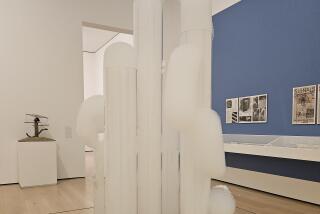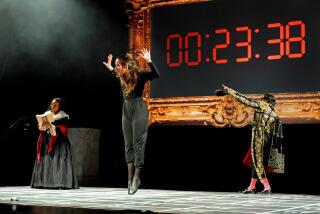LOS ANGELES FESTIVAL : JOHN CAGE: His Art and His Music
Composer John Cage had difficulty in his youth deciding whether to tilt toward music or visual art. Influential advisers argued for music--with legendary results--but Cage was never one to tie himself to one discipline, much less follow its established forms. While he gave up painting and architecture, he has collaborated with artists and dancers, influenced the development of “happenings” and exhibited his hand-written scores.
Now celebrating his 75th birthday with a series of music and multidisciplinary events in the Los Angeles Festival, Cage serves as its spiritual godfather. For visual artists, he is also the strongest connection to a festival that has effectively excluded them. “John Cage: Changing Art,” a show of Cage’s prints, at the Los Angeles Theatre Center (through Saturday), is the first of only two exhibitions sponsored by the festival. The second, Piero Tauro’s photographs of dance, also at the LATC (Sept. 15-27), promises to be artful documentation.
Given the context, “Changing Art” is a surprisingly substantial show offering visual evidence of the composer’s philosophy. An advocate of chance and indeterminacy, Cage subverts the notion of artists as strong personalities who express themselves through masterpieces. Hoping to open minds to changes inherent in a modern world, he has written of “purposeless play” as a discovery process and “an affirmation of life.”
He has thrived on Oriental influence, adopting Zen’s intense awareness of everyday life, the Buddhist belief that all things are related and the I Ching (Book of Changes) as a guide to chance operations.
“Changing Art” presents these ideas through four groups of prints created at Crown Point Press in San Francisco from 1979 to 1985. The largest batch is “Changes and Disappearances,” a series of 35- color etchings. Looking windblown but delicate and pristine, they resemble mixtures of grass cuttings, threads, bits of paper and shards of glass.
All printed on 11-by-22-inch sheets of sand-colored paper, the etchings were created from eight copper plates, cut into 66 pieces. Cage assigned each piece a number, imprinted them with lines or photographic images from the journals of Henry David Thoreau, then selected segments to be printed with the help of the I Ching.
Four color etchings from “Dereau,” a suite of 38 images, also uses bits of Thoreau’s drawings and “substitutions” for them in the form of solid-color shapes or lines that may represent horizons or curves determined by a length of string dropped on the plate.
The six drypoints in “Where R=Ryoanji” are composed of overlapping tracings of rocks collected from various parts of the world and selected for the prints by chance. Now arranged in a vertical line, they form a descending progression from wiry circles to dense snarls.
Rocks also figure in 13 “Ryoku” drypoints. Here Cage has overlaid outlines of six small stones on imprints of odd-shaped copper plates. Containing clustered images that appear quite consciously composed, these prints suggest an interplay between man-made and natural forms.
Throughout the show, Cage maintains a characteristically light touch, letting his system take over as he creates art in spite of himself. We’ve grown so weary of chest thumpers and glamorous art stars, it’s refreshing to encounter someone who would rather discover images than pull them out of a tortured mind or an anguished soul.
The theater’s gallery opens at 6 on evenings of performances.
More to Read
The biggest entertainment stories
Get our big stories about Hollywood, film, television, music, arts, culture and more right in your inbox as soon as they publish.
You may occasionally receive promotional content from the Los Angeles Times.










